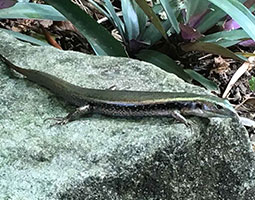Eulamprus quoyii
Description

The Golden Water Skink (Eulamprus quoyii) is sometimes referred to as the Eastern Water Skink and is found from Far-North Queensland to South-East NSW. They are a large skink, growing to about 30cm, and are commonly found in suitable habitat around permanent water bodies (such as rivers and creeks) where suitable cover exists. Here they can bask in the sun to get warm or cool themselves off in the water depending on how hot they feel.
If attacked the Golden Water Skink can drop its tail and quickly run away. The tail will wiggle on the spot and attract the attention of predators giving the skink a chance to escape.
These skinks breed in spring and give birth to live young (viviparous) in summer. The litter of 2—9 young are then left to fend for themselves after they are born.
Adaptations
- The black, brown, copper and white stripes/spots on their bodies are great camouflage in the leaf litter
- These skinks will threaten each other by bobbing their heads vigorously to warn off rivals
- They have the ability to submerge themselves beneath the water for extended periods of time
- They are very fast and active at temperatures above 25 degrees Celsius
Feeding relationships
- What I eat: Small insects, worms, snails, spiders, aquatic insects, tadpoles some plant matter such as fruit and berries and even small skinks
- What eats me: Birds (Kookaburra, Butcher Birds), large lizards like water dragons and Lace monitors, domestic cats, small snakes and even some turtles
Interesting facts
Golden Water Skinks, like most other lizards and snakes, are excellent swimmers. They have also been known to be quite cheeky by stealing dog and cat food from their bowls.